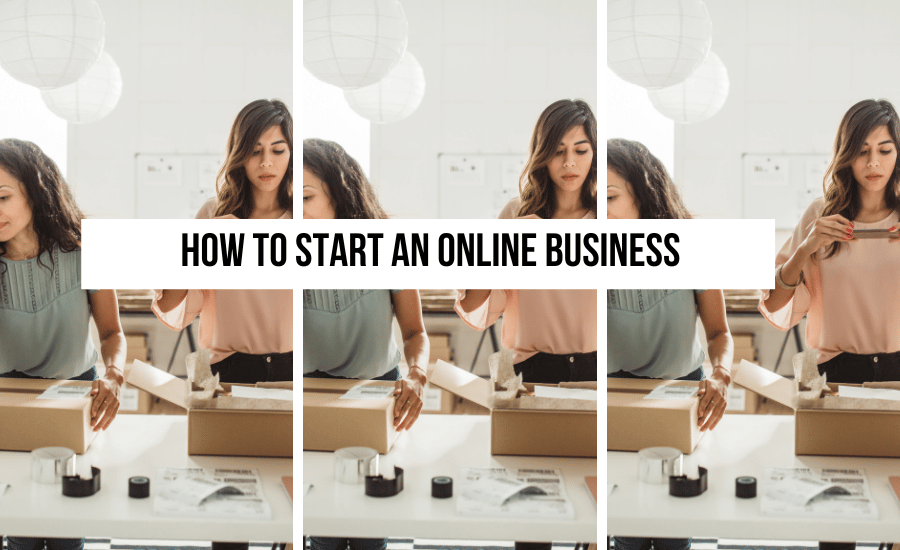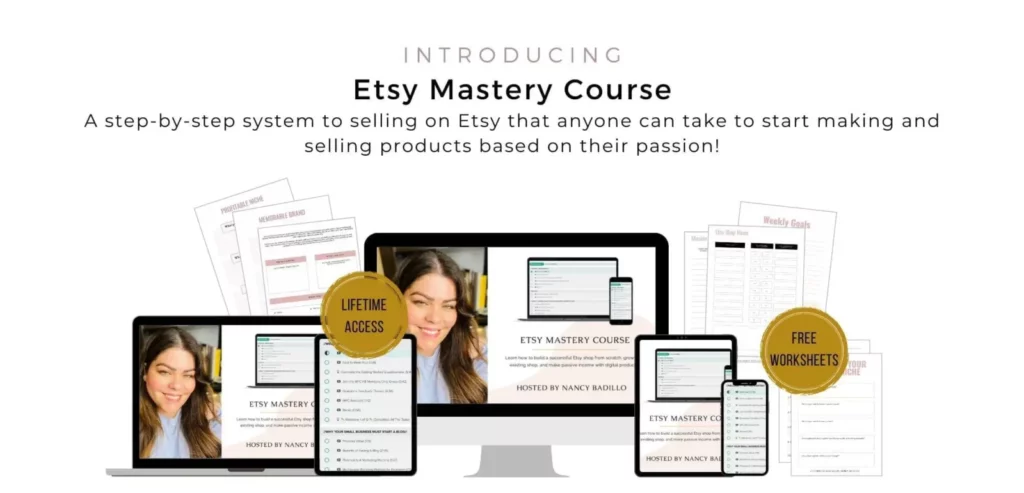Are you ready to embark on the exciting journey of how to start an online business? In today’s digital age, the opportunities for success are endless, and with the right strategy, dedication, and a touch of creativity, you can turn your passion into a thriving online venture. Whether you dream of becoming a successful e-commerce entrepreneur, a sought-after freelancer, or a digital influencer, this guide will equip you with the essential knowledge and tools to get started on the right foot.
From identifying your niche and building an effective online presence to attracting and retaining customers, we will delve into the key steps and strategies that will pave the way for your online business success. So, if you’re ready to take control of your future, unleash your entrepreneurial spirit, and join the rapidly expanding world of online business, then let’s dive in and discover how to turn your dreams into reality. Let’s dive into how to start an online business.

This blog post is all about how to start an online business.
Home > Make Money > How To Start An Online Business
DISCLOSURE: This is a sponsored post. Through my links, I may receive a commission if you decide to make purchases at no cost for yourself! Check out our disclaimer for more info on how it works.
Ready to embark on your Etsy business journey but unsure where to begin? Join our free masterclass, where we empower you to start, manage, and scale your Etsy business into a full-time income. With our guidance, 9,000+ individuals have found success, even without a social media presence or email list. Step into the world of Etsy entrepreneurship, and let us guide you to success. Join us now!
Table of contents
- Finding Your Niche and Target Audience
- Conducting Market Research
- Creating a Business Plan
- Building Your Online Presence
- Choosing the Right E-commerce Platform
- Creating a Website and Optimizing It for SEO
- Setting Up Payment Gateways and Shipping Options
- Developing a Marketing Strategy for Your Online Business
- Conclusion: how to start an online business
- Ready To Start An Etsy Business?
- New On The Blog
Finding Your Niche and Target Audience
Before we dive headfirst into how to start an online business, it’s essential to identify your niche and target audience. Your niche is the specific area or industry you want to focus on, while your target audience is the group of people who are most likely to be interested in your products or services. Finding the right niche and target audience is crucial for your business’s success as it allows you to tailor your offerings to meet their specific needs and preferences.
To find your niche, start by brainstorming your passions, skills, and interests. What are you truly passionate about? What are your areas of expertise? By narrowing down your focus to something you genuinely enjoy, you’ll be more motivated to put in the necessary work and stay committed to your business. Additionally, consider the market demand for your chosen niche. Is there a need or gap that you can fill? Conducting market research will help you determine the viability and potential profitability of your chosen niche.
Once you’ve identified your niche, it’s time to define your target audience. Who are the people most likely to be interested in your products or services? Consider factors such as demographics (age, gender, location), psychographics (interests, values, lifestyle), and behavior (online shopping habits, purchasing power). Understanding your target audience will enable you to tailor your marketing efforts and create a more personalized experience for your customers.
Conducting Market Research
Market research is a vital step in the process of starting an online business. It involves gathering and analyzing information about your industry, competitors, and target audience to make informed business decisions. By conducting thorough market research, you can gain valuable insights that will guide your marketing strategy, product development, and overall business direction.
Start by researching your industry. What are the current trends and market conditions? Are there any significant challenges or opportunities? Understanding the broader landscape will help you position your business effectively and stay ahead of the competition. Next, analyze your competitors. Who are the key players in your niche? What products or services do they offer? How do they market themselves? By studying your competitors, you can identify gaps in the market that you can capitalize on and differentiate yourself from the competition.
Once you have a clear understanding of your industry and competitors, it’s time to focus on your target audience. Conduct surveys, interviews, or use online tools to gather insights about their preferences, pain points, and buying behavior. This information will help you tailor your offerings to meet their specific needs and create a more compelling value proposition. Additionally, keep an eye on industry publications, forums, and social media platforms to stay updated on the latest trends, challenges, and opportunities in your niche.
Creating a Business Plan
A well-thought-out business plan is the foundation of every successful online business. It serves as a roadmap that outlines your goals, strategies, and action steps for achieving them. A business plan not only helps you stay focused and organized but also serves as a valuable tool when seeking funding or partnerships.
Start by defining your business’s mission and vision. What do you hope to achieve with your online business? What values and principles will guide your decision-making process? Next, set clear and measurable goals. Are you aiming for a specific revenue target? Do you want to reach a certain number of customers within a given timeframe? Setting SMART (Specific, Measurable, Achievable, Relevant, Time-bound) goals will keep you motivated and give you a clear direction to work towards.
Once you have defined your mission, vision, and goals, it’s time to develop strategies and action plans to achieve them. Identify the key strategies you will use to attract and retain customers, such as content marketing, social media advertising, or email marketing. Outline the steps you need to take to build your online presence, develop your products or services, and generate revenue. Additionally, consider the financial aspects of your business, such as budgeting, pricing, and cash flow projections.
Remember, a business plan is not set in stone and should be reviewed and updated regularly as your business evolves. It’s a dynamic document that will guide your decision-making process and help you stay on track towards your goals. Don’t be afraid to seek feedback from mentors, business advisors, or fellow entrepreneurs to ensure your business plan is comprehensive and realistic. By doing this you’re in the path to effectively learning how to start an online business.
Building Your Online Presence
Building a strong online presence is essential for the success of your online business. It’s how you establish credibility, attract customers, and differentiate yourself from the competition. Your online presence encompasses your website, social media profiles, content, and overall brand identity. Here are some key steps to building a compelling online presence:
Start with a professional website. Your website is the foundation of your online business and often the first point of contact for potential customers. Ensure your website is visually appealing, user-friendly, and optimized for search engines. Use high-quality images, clear and concise messaging, and easy navigation to create a positive user experience. Additionally, make sure your website is mobile-responsive, as an increasing number of people access the internet via mobile devices.
Optimize your website for search engines. Search engine optimization (SEO) is the process of improving your website’s visibility in search engine results. By optimizing your website’s content, structure, and technical aspects, you can increase your chances of ranking higher in search engine results pages (SERPs). Conduct keyword research to identify relevant keywords and incorporate them naturally into your website’s content. Additionally, focus on creating high-quality, relevant, and informative content that provides value to your target audience.
Establish a strong social media presence. Social media platforms offer a powerful way to connect with your target audience, build brand awareness, and drive traffic to your website. Choose the social media platforms that are most relevant to your target audience and create compelling profiles. Consistently post engaging content, interact with your followers, and leverage social media advertising to expand your reach. Use analytics and insights to track your social media performance and optimize your strategies accordingly.
Create valuable and engaging content. Content marketing is a powerful strategy for attracting and retaining customers. Create high-quality, relevant, and valuable content that addresses the needs and interests of your target audience. This can include blog posts, videos, infographics, or podcasts. Share your content on your website, social media platforms, and other relevant channels to increase your visibility and establish yourself as an authority in your niche to learn how to start an online business.
Choosing the Right E-commerce Platform
Choosing the right e-commerce platform is crucial for the success of your online business. An e-commerce platform is a software solution that allows you to build and manage your online store, process payments, and handle inventory and shipping. With numerous e-commerce platforms available, it’s essential to consider your specific needs, budget, and technical expertise before making a decision.
When choosing an e-commerce platform, consider factors such as:
– Ease of use: Look for a platform that is user-friendly and intuitive, allowing you to easily manage your online store without technical expertise.
– Customization options: Ensure the platform allows you to customize your store’s design, layout, and branding to create a unique and personalized shopping experience for your customers.
– Payment gateways: Check which payment gateways the platform supports and whether they align with your customers’ preferences.
– Inventory management: If you plan to sell physical products, consider whether the platform offers robust inventory management features to help you keep track of stock levels and automate the ordering process.
– SEO capabilities: Look for a platform that is SEO-friendly, allowing you to optimize your product pages and improve your chances of ranking higher in search engine results.
– Scalability: Consider your long-term growth plans and choose a platform that can accommodate your future needs and handle increased traffic and sales.
By carefully evaluating your options and choosing the right e-commerce platform, you’ll have a solid foundation for your online business and be well-equipped to handle the operational aspects of running an online store.
Creating a Website and Optimizing It for SEO
A well-designed and optimized website is crucial for the success of your online business. It’s where potential customers will go to learn more about your products or services and make a purchase. Here are some key steps to creating a compelling website:
Choose a domain name. Your domain name is your website’s address on the internet, so choose a name that is memorable, easy to spell, and relevant to your business. Consider using keywords related to your niche to improve your chances of ranking higher in search engine results.
Select a website builder or content management system (CMS). A website builder or CMS allows you to create and manage your website without technical expertise. Choose a platform that aligns with your needs and offers the flexibility and customization options you require. Popular options include WordPress, Shopify, and Wix.
Design your website. Your website’s design should be visually appealing, user-friendly, and aligned with your brand identity. Use high-quality images, clear and concise messaging, and intuitive navigation to create a positive user experience. Consider the principles of responsive design to ensure your website looks great on all devices.
Optimize your website for SEO. Search engine optimization (SEO) is the process of improving your website’s visibility in search engine results. Conduct keyword research to identify relevant keywords and incorporate them naturally into your website’s content. Optimize your meta tags, headings, and image alt text. Additionally, focus on creating high-quality, valuable, and informative content that addresses the needs and interests of your target audience.
Ensure your website is mobile-responsive. With an increasing number of people accessing the internet via mobile devices, it’s essential to ensure your website looks and functions well on smartphones and tablets. Choose a responsive design that automatically adjusts to different screen sizes and resolutions.
Test and optimize your website. Regularly test your website’s performance, load times, and user experience. Use analytics and data to identify areas for improvement and optimize your website accordingly. Consider conducting user testing or seeking feedback from friends, family, or customers to ensure your website is user-friendly and intuitive.
By following these steps, you’ll be well on your way to creating a visually appealing, user-friendly, and SEO-optimized website that attracts and converts visitors into customers.
Setting Up Payment Gateways and Shipping Options
Setting up payment gateways and shipping options is a crucial step in the process of starting an online business. It’s how you enable customers to make purchases and receive their orders. Here are some key considerations when setting up payment gateways and shipping options:
Choose payment gateways that align with your customers’ preferences. Consider popular options such as PayPal, Stripe, or Square, as well as any local or regional payment methods that are relevant to your target audience. Ensure the payment gateways you choose are secure, user-friendly, and offer competitive transaction fees.
Offer a variety of shipping options. Different customers have different preferences when it comes to shipping. Some may prioritize speed, while others may prioritize cost. Offer a range of shipping options, such as standard shipping, express shipping, or free shipping above a certain order value. Consider partnering with reliable shipping providers or fulfillment centers to ensure timely delivery and efficient order management.
Calculate shipping costs accurately. Shipping costs can significantly impact a customer’s decision to make a purchase. Use shipping calculators or plugins to accurately calculate shipping costs based on factors such as package weight, destination, and shipping method. Consider offering free shipping for orders above a certain value to incentivize larger purchases.
Communicate shipping policies clearly. Clearly communicate your shipping policies, including estimated delivery times, return and exchange policies, and any restrictions or limitations. Ensure your customers have all the information they need to make an informed purchasing decision.
Test the payment and shipping processes. Before launching your online business, thoroughly test the payment and shipping processes to ensure they work smoothly. Place test orders, simulate different scenarios, and seek feedback from friends or family to identify any issues or areas for improvement.
By setting up reliable and user-friendly payment gateways and offering a variety of shipping options, you’ll provide a seamless and convenient purchasing experience for your customers, leading to increased customer satisfaction and loyalty.
Developing a Marketing Strategy for Your Online Business
A well-defined marketing strategy is essential for attracting and retaining customers for your online business. It’s how you promote your products or services, build brand awareness, and drive traffic to your website. Here are some key steps to developing an effective marketing strategy:
Define your target audience. Clearly identify your target audience based on demographics, psychographics, and behavior. Understanding your target audience will help you tailor your messaging and choose the most effective marketing channels.
Set marketing goals. Define clear and measurable marketing goals that align with your overall business objectives. Are you aiming for a certain number of website visits, social media followers, or conversions? Setting specific goals will help you stay focused and track your progress.
Choose the right marketing channels. Consider the marketing channels that are most relevant to your target audience and industry. This could include social media platforms, search engine marketing (SEM), content marketing, email marketing, or influencer marketing. Choose channels that align with your budget, resources, and marketing goals.
Create compelling and valuable content. Content marketing plays a significant role in attracting and engaging your target audience. Create high-quality, relevant, and valuable content that addresses their needs, interests, and pain points. This could include blog posts, videos, infographics, or podcasts. Share your content on your website, social media platforms, and other relevant channels to increase your visibility and establish yourself as an authority in your niche.
Leverage social media and content marketing. Social media platforms offer a powerful way to connect with your target audience, build brand awareness, and drive traffic to your website. Develop a social media strategy that includes consistent posting, engaging with your followers, and leveraging social media advertising to expand your reach. Additionally, use content marketing to create valuable and informative content that attracts and retains customers.
Implement email marketing and lead generation tactics. Email marketing is a highly effective strategy for nurturing leads and converting them into customers.
Conclusion: how to start an online business
In conclusion, starting an online business requires careful planning, dedication, and a solid understanding of the digital landscape. By following the step-by-step guide on how to start an online business, you can navigate the complexities and set yourself up for success.
From identifying a profitable niche to creating a compelling online presence, leveraging effective marketing strategies, and providing exceptional customer experiences, the key is to stay focused and adapt to the ever-evolving online marketplace. With the right mindset and the right tools, you can turn your entrepreneurial dreams into a thriving online business. So, take the leap, embrace the journey, and discover the endless possibilities of digital entrepreneurship.
Ready To Start An Etsy Business?
If you’re considering starting your own Etsy store but unsure about which products to offer, my signature course, the Etsy Mastery Course, is your ultimate guide. Learn how to start, manage, and scale your Etsy business to a full-time income.


+ show Comments
- Hide Comments
add a comment